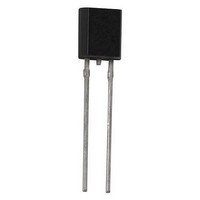TISP4300H3LMFR Bourns Inc., TISP4300H3LMFR Datasheet - Page 8

TISP4300H3LMFR
Manufacturer Part Number
TISP4300H3LMFR
Description
SURGE SUPP THYRISTOR 230V TO-92
Manufacturer
Bourns Inc.
Specifications of TISP4300H3LMFR
Package / Case
TO-92-2, TO-226AC
Voltage - Breakover
300V
Voltage - Off State
230V
Voltage - On State
3V
Current - Peak Pulse (8 X 20µs)
300A
Current - Peak Pulse (10 X 1000µs)
100A
Current - Hold (ih)
150mA
Number Of Elements
1
Capacitance
62pF
Mounting Style
Through Hole
Lead Free Status / RoHS Status
Lead free / RoHS Compliant
Specifications are subject to change without notice.
Customers should verify actual device performance in their specific applications.
These devices are two terminal overvoltage protectors. They may be used either singly to limit the voltage between two conductors (Figure 12)
or in multiples to limit the voltage at several points in a circuit (Figure 13).
In Figure 12, protector Th1 limits the maximum voltage between the two conductors to ±V (BO) . This configuration is normally used to protect
circuits without a ground reference, such as modems. In Figure 13, protectors Th2 and Th3 limit the maximum voltage between each conduc-
tor and ground to the ±V (BO) of the individual protector. Protector Th1 limits the maximum voltage between the two conductors to its ±V (BO)
value. If the equipment being protected has all its vulnerable components connected between the conductors and ground, then protector Th1
is not required.
To verify the withstand capability and safety of the equipment, standards require that the equipment is tested with various impulse wave forms.
The table below shows some common values.
If the impulse generator current exceeds the protector’s current rating, then a series resistance can be used to reduce the current to the
protector’s rated value to prevent possible failure. The required value of series resistance for a given waveform is given by the following
calculations. First, the minimum total circuit impedance is found by dividing the impulse generator’s peak voltage by the protector’s rated
current. The impulse generator’s fictive impedance (generator’s peak voltage divided by peak short circuit current) is then subtracted from the
minimum total circuit impedance to give the required value of series resistance. In some cases, the equipment will require verification over a
temperature range. By using the rated waveform values from Figure 11, the appropriate series resistor value can be calculated for ambient
temperatures in the range of -40 °C to 85 °C.
NOVEMBER 1997 - REVISED JANUARY 2007
Deployment
Impulse Testing
TISP4xxxH4BJ Overvoltage Protector Series
ITU-T K.20/K.21
Figure 12. Two Point Protection
† FCC Part 68 terminology for the waveforms produced by the ITU-T recommendation K.21 10/700 impulse generator
GR-1089-CORE
(March 1998)
FCC Part 68
Standard
I3124
Peak Voltage
Th1
Setting
2500
1000
1500
1500
1000
1500
1500
4000
800
V
Waveform
10/1000
Voltage
9/720 †
9/720 †
0.5/700
10/160
10/560
10/700
2/10
µs
APPLICATIONS INFORMATION
Peak Current
Value
37.5
37.5
37.5
500
100
200
100
100
25
A
Figure 13. Multi-point Protection
Waveform
10/1000
Current
5/320 †
5/320 †
0.2/310
10/160
10/560
5/310
2/10
µs
Th1
25 °C Rating
TISP4xxxH4
500
100
250
160
200
200
200
200
A
Th3
Th2
Resistance
Series
Ω
0
0
0
0
0
0
0











